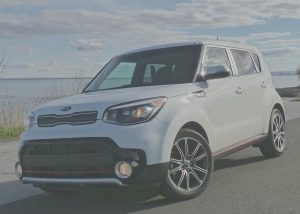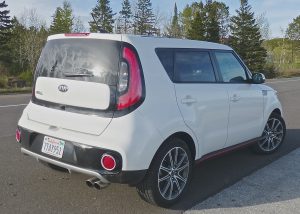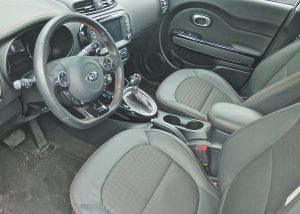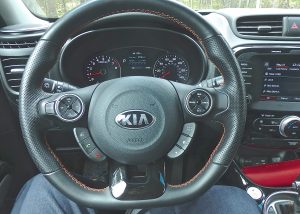Soul’s new turbo model outruns the last cynics

The Soul’s slightly stretched form might be harder to detect than the added zip from its turbocharged 1.6.
By John Gilbert
Maybe some engineer lost a bet, or maybe in a lighthearted moment the more rebellious side of Kia just wanted to do something out of the ordinary. Whatever, the feeling persists that when Kia first introduced the Soul it was intended to be more of a short-term, square gimmick car than a long-term player in the Kia automotive stable.
But after seeming to almost hurry to get past the square one and on to more significant models like the Optima, Rio, Forte, Sportage and Sorento, the Soul has grown up and acquired a robust personality, and for 2017 it is finally getting some equipment that makes it far more than the square 4-door, which still holds four large adults and a lot of luggage.
Would you believe the Soul is getting a hot turbocharged 4-cylinder with a 7-speed dual-clutch transmission as indications that it is living up to some sort of potential a lot of us never realized it had?
The Soul ! I test-drove had the Kia-Hyundai corporation’s quick-revving 1.6-liter 4-cylinder, turbocharged, along with the corporate 7-speed dual-cutch transmission, which shifts automatically, as two internal clutches trade off instantaneously engaging the next gear up or down.
It’s the perfect transmission for the turbo 1.6, which has now become my favorite Hyundai or Kia engine because of its surprising potency, while retaining fuel economy in the mid-30s with gusts to near 40.
The 1.6 turbo in the Soul ! jumps up to 178 horsepower and 195 foot-pounds of torque, converting the vehicle into a sleeper well-deserving of the exclamation point in its name. The basic Soul 1.6 has 130 horsepower and 118 foot-pounds of torque, adequate for a mall-runner maybe. Upgrade to the 2.0 and you get a healthy 164 horses and 154 foot-pounds. The turbo is another story.
The test car also proves Kia remains unpretentious. It was gleaming white with black leather interior, and you have to be impressed with a company that could paint something that could be called “creamy vanilla metallic pearl” — and yet instead officially calls it: “clear white,” while the interior is called “black.”
I recall the introduction of the first Soul, several years ago in Miami, where Kia officials allowed us to drive these small, square compact cars around the city’s suburban regions. First, though, they showed us videos of the ad campaign, in which some large, stuffed, cartoonish hamsters drove along, bobbing their heads in rhythm as they did.
The Soul itself was an interesting venture, definitely square everywhere, in overall dimensions and angles. Nissan and Toyota, through its late Scion branch, tried their hands at square little compacts, neither with much success.
After the presentation, Kia officials acted apologetic, as though the large stuffed hamsters were beneath the dignity of the South Korean company. I disagreed; I thought the hamsters were the greatest potential car advertising “hook” I’d seen in years, and Kia should be stressing them.
A couple of months later, Kia invited me to the introduction of the first Forte, a conventionally shaped compact, in Seattle. During the presentation, one official said, “Don’t worry, there won’t be any hamsters at this one” — still apologizing. I got the distinct feeling that some Kia executives let the designers have their day, but anticipated nothing approaching success for the Soul.
Strangely enough, however, the car did pretty well, and continued to do better than expected as it turned into the funky everything-hauler in the Kia line, possibly succeeding because it was in a large field where a lot of competitors looked alike andc had no personality. The Soul had…well, “soul.”
The hamsters came back strong, rising in popularity as the car did, although the company has resisted letting the little furry critters become the corporate symbol, keeping them restricted to the Soul.
For 2017, though, the breakthrough is here as the Soul gets redone for about the fourth time. Casual car observers might not notice the subtleties of the changes. I did, this time, during a week-long chance to live with the Soul and drive it extensively. The Soul I drove was properly identified as the “Soul !” — with the exclamation point supplied by the company. There are different models of Souls now, and while they all retain that squarish shape, it has been refined, and elongated.

The large lower grille, and the foglights at the lower extremities, give the Soul a serious-driver demeanor.
My initial fears were that the first Soul models could be air dams in high winds, because of their shape. The new car allays those concerns and feels more planted, as I drove through all kinds of crosswinds to try it out, and it felt stable always.
It also felt quick, like the closet street-racer it could be. That’s because the storehouse of powertrains that Hyundai and its partner Kia now have at their disposal includes several 4-cylinders, with the 2.4 and 2.0 being the most popular up until a couple of years ago, when the smaller 1.6-liter engine was revised and strengthened. Adding a turbocharger option puts some models over the top.
The slightly elongated nose is enhanced by foglights at the lower corners, flanking the low but businesslike grille. The interior, which always had been catchy in the Soul, is now redesigned to add a sporty flair, with full instrumentation and a flat-bottomed steering wheel with all the proper remote switches. You can adjust the mode for driving from normal to eco or the other way to sport, which holds the revs longer and firms up the steering and suspension a bit.
That further aids the new personality of the sportier Soul ! and allows you to more appreciate all the driving aids built into the car, such as traction control, stability control, stability management system, and a hill-start assist to prevent the Soul ! from being tempted to roll back into the grille of the car behind you when starting up from being stopped on a hill.
A full complement of airbags and curtains envelops the interior and the latest connectivity tricks adorn the inside, with Bluetooth and both Apple and Android faculties. With leather and cloth interior, and leather shift knob and steering wheel, plus push-button start with keyless door locks, the Soul ! shows a base price of $22,650, which is a great bargain for such a sophisticated vehicle.
More impressive is that all the components are standard, so the total sticker is $23,620 after destination charges. Because of its size and shape, the Soul seats four adults with plenty of head and legroom, and still has a surprising amount of room under the rear hatch. With front-wheel drive, it should do fine in winter, with the right tires, but all its life I’ve been hoping Kia would put all-wheel drive in the Soul.
But we’ll take what we can get. Performance is up, handling and pep and agility rise with it, and even aerodynamics. And I still like to go back to the down-to-earth official color scheme of the test car — white, and black. That’s a major step backward from the hyperbole that is almost laughable in excesses at other manufacturers. But what else should we expect from a group that was too shy to promote its hamsters.
Its shape can confuse you. Is it a mini station wagon, a downsized mini-minivan, or just a hatchback that happens to be squared off? We don’t know. And neither, apparently, does JD Power, the outfit that tests and compares and awards all sorts of vehicles these days. The Soul for last year, 2016, won its second straight award for being the “highest ranked multi-purpose vehicle in initial quality.”
Multi-purpose might mean that the Soul can haul people, stuff, and even the occasional family of hamsters.





 John Gilbert is a lifetime Minnesotan and career journalist, specializing in cars and sports during and since spending 30 years at the Minneapolis Tribune, now the Star Tribune. More recently, he has continued translating the high-tech world of autos and sharing his passionate insights as a freelance writer/photographer/broadcaster. A member of the prestigious North American Car and Truck of the Year jury since 1993. John can be heard Monday-Friday from 9-11am on 610 KDAL(www.kdal610.com) on the "John Gilbert Show," and writes a column in the Duluth Reader.
John Gilbert is a lifetime Minnesotan and career journalist, specializing in cars and sports during and since spending 30 years at the Minneapolis Tribune, now the Star Tribune. More recently, he has continued translating the high-tech world of autos and sharing his passionate insights as a freelance writer/photographer/broadcaster. A member of the prestigious North American Car and Truck of the Year jury since 1993. John can be heard Monday-Friday from 9-11am on 610 KDAL(www.kdal610.com) on the "John Gilbert Show," and writes a column in the Duluth Reader.